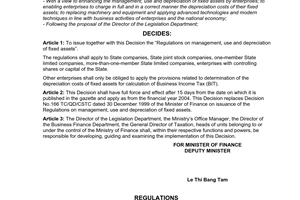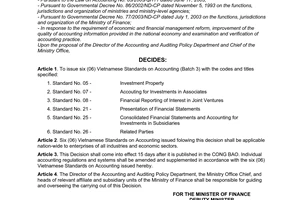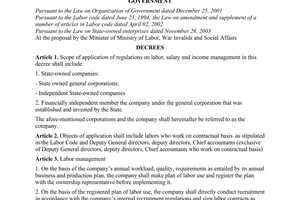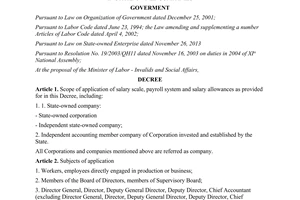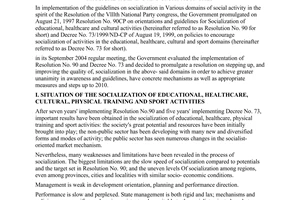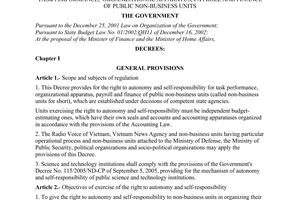Nội dung toàn văn Circular No. 15/2007/TT-BYT autonomy of public medical facilities for using assets as capital for purchasing equipment
|
THE MINISTRY OF HEALTH |
THE SOCIALIST REPUBLIC OF VIETNAM |
|
No. 15/2007/TT-BYT |
Hanoi, December 12th, 2007 |
CIRCULAR
GUIDELINES FOR AUTONOMY OF PUBLIC MEDICAL FACILITIES FOR USING ASSETS AS CAPITAL FOR PURCHASING EQUIPMENT SUPPORTING SERVICE PROVISION IN A PARTNERSHIP
Pursuant to the Resolution no. 05/2005/NQ-CP dated April 18th, 2005 of the Government on the socialization of education, health, culture and sport;
Pursuant to the Resolution no. 43/2006/NĐ-CP dated April 25th, 2006 of the Government regulating the autonomy of public service providers for tasks performance, organizational apparatus, personel and finance;
Pursuant to the Official Dispatch no.16586/BTC-HCSN dated December 05th, 2007 of the Ministry of Finance;
The Ministry of Health provides guidance on autonomy of public medical facilities with regard to the use of assets for entering into a partnership in order to purchase equipment supporting service provision as follows:
I. SCOPE AND REGULATED ENTITIES
1. The entities below are regulated by this Circular:
a) the public medical facilities established under the approval of competent State agencies (including the training institutions under the management of the Ministry of Health), which are independent units with their own stamps, accounts, and accounting apparatus according to the Law on Accounting, permitted to enter into partnerships in order to meet the social demand in compliance with the Law.
b) the public medical facilities classified by competent agencies as public service providers which are fully/partly financially independent, permitted to enter into partnerships with domestic or foreign entities in order to invest in equipment supporting service provision in meeting the social demand in compliance with the Law.
c) the financially independent organizations affiliated to public service providers which are established for providing services, in accordance with the assigned functions and tasks, and with the scheme for the autonomy of task performance, organizational apparatus, personel and finance of the public service providers;
d) The domestic or foreign entities contributing capital in form of money or assets to partnerships for providing services.
2. Forms of assets contribution to enter into partnerships between public medical facilities and organizations and individuals (hereinafter referred to as partners) to purchase equipment supporting service provision according to this Circular are as follows:
a) Contributing capital in assets which are equipment, houses, infrastructure of partners and medical facilities to provide services, account for expenditures and share income depending on the proportion of contribution and participation of the parties.
b) Contributing capital in form of money of public medical facilities and partners to purchase equipment supporting service provision.
c) Contributing investment in equipment of partners, the public medical facilities provide services and share income to partners depending on the service sale (rent equipment and pay depending on service sale).
3. The regulated services according to this Circular include: examination, treatment, functional recovery, prophylaxis, training provision, scientific research, screening and supply of preparations made from vaccines, biological products; laundry services, food and drink, patient transport and other supporting service provision.
II. GENERAL PROVISIONS
1. The use of assets for entering into partnerships to purchase equipment supporting service provision must depend on the demand of public medical facilities and the organizations affiliated to public service providers (hereinafter referred to as units) and in accordance with approved functions, tasks and development scheme, and not affect professional tasks assigned by competent agencies.
2. Technical equipment must be in conformity with each unit’s technical class. In order to purchase technical equipment using technology beyond the regulated technical class of a unit, the unit must send an application to the higher management authority for assessment and approval according to regulation on technical classification and list of medical examination and treatment enclosed with Decision no. 23/2005/QĐ-BYT dated August 30th, 2005 of the Ministry of Health.
3. Using assets as capital for entering into a partnership must ensure the economic efficiency and ensure the principle of harmony of interests between the unit, patients and partners.
4. Price of services shall be agreed between the head of the unit and partners on the principle of covering expenditures and accumulating reasonably reserve funds.
5. The depreciation of equipment and assets shall be included in the service price under the depreciation policy applied for state-owned enterprises according to the Decision no. 206/2003/QĐ-BTC dated December 12th 2003 of the Minister of Finance. In some special cases, the head of a unit has the right to decide a depreciation proportion in service price that higher than regulated ones in order to recover capital in regard to technically obsolete assets. However, the service price must not be higher than one in the case of fixed asset depreciation at normal rate and not exceed 50% of the straight-line depreciation proportion of such asset. When applying accelerated depreciation, the unit must ensure covering expenditures and reserve funds, suitable for the financial capacity of patients.
6. Obligations must be fulfilled according to current regulations of the Law.
7. The units have responsibility to publicly list the services and prices of partnerships. The acts of suggesting or forcing patients to use the services supported with equipment of partnerships while the unit owns such equipment that capable to serve are prohibited.
8. The capital for a unit to enter into partnerships is taken from the budget for service provision development; loan capital; capital mobilized from staff of the unit. The unit using its assets as capital must comply with the regulations of the Law on management and use of State Assets (according to Article 11, Decision no 202/2006/QĐ-TTg dated August 31st 2006 of the Prime Minister regulation on management of State Assets in public service providers).
III. SPECIFIC PROVISIONS
1. Policy and authorization for scheme approval
a) The policy for using assets as capital to enter into partnerships in order to invest in equipment supporting service provision must be publicly and democratically discussed and agreed in written among the Board of Director, the Party Committee and the Labor Union.
b) After the policy is formulated, the unit shall make the selection of partner, type of partnership, equipment according to this Circular.
c) The unit and the partners shall set up a Scheme for using assets as capital to enter into a partnership with domestic or foreign entities; the scheme must contain all the contents prescribed in section IV of this Circular. The Scheme shall be approved by the head of the unit on the basis of the written agreement between the local Government, the Party Committee and the Labor Union of the unit. The head of the unit shall be liable to the higher management authority and the Law for approving and carrying out the Scheme.
d) The units must send the approved Scheme to the higher management authority for monitoring, inspecting and supervising. In case the Scheme contains any inappropriate content to the Regulations of the Government, within 15 (fifteen) days from the receipt of the Scheme, the higher management authority must send a written request the unit to modify the Scheme.
2. Partner selection:
a) Partners must have legal status and sufficient financial capability, except the case of capital mobilization from staff of a unit.
b) The partner selection must be publicly democratically discussed and agreed among Party Committee, Board of Director and Labor Union of a unit. The units should negotiate with many candidates in order to select appropriate partners meeting requirements for service quality and patients' interest guarantee.
3. Equipment
a) The equipment invested for carrying out the Scheme by partners must be brand new, advanced, upgradeable, and with Certificates of Quality and Origin. The specialist equipment with other requirements (radiotherapy equipment) must comply with the regulations on radiation safety and approved by competent agencies.
b) It is prohibited to purchase and install used medical equipment or the equipment which is not permitted to import by the Ministry of Health, except the case a public medical facility make use of its own assets as capital for entering into a partnership.
c) With regard to medical equipment using advance technology for examination or treatment i.e. Angiography system, Magnetic resonance imaging system, Computed Tomography scanner, Radiotherapy equipment (including Cobalt 60, Linear Accelerator, Gamma knife and Cyber knife radio surgery systems), Lithotripter, Laser Excimer (the list shall be updated by the Ministry of Health on request), the equipment using technology beyond the regulated technical class of a unit:
- A unit must establish a Board of Science and Technology with the participation of experts in equipment and relevant specialities for assessing the configuration and technical functions of the equipment mentioned in the Scheme.
- In case a unit does not have any experts, the unit must invite experts or request for advice from the Technical advisory board of medical equipment of the Ministry of Health under the management of Department of Medical Equipment and Works.
4. Rules for determining value of assets used as capital
a) Prices of brand new equipment depend on:
- Bidding results for similar equipment of a public unit of which contracts are awarded within 06 months prior to the determination.
- Value announcement of the value management authorities according to the regulations of the Government.
- With regard to assets without any bidding result or value announcement: the head of the unit shall consider the declaration of imported goods and/or sale contract of the assets to determine the purchase price, enclosed with goods assessment certificates on: condition, type, origin, manufacturer, manufacture date, specification, quality.
b) With regard to assets of a unit which are houses, infrastructure and used equipment:
- The unit must establish a Board for assessing and determining the value of the assets.
- The determination of an asset value is according to the asset condition and the unit price for purchasing a brand new one in the area at the time of determination.
|
The value of an asset (VND) |
= |
The proportion of its condition (%) |
x |
Price for purchasing a brand new asset at the time of determination (VND) |
+ Proportion (%) of the condition of an asset is determined according to the kind, life time and used time of the asset. The assets which are houses and infrastructure shall comply with section II of the Joint Circular of the Ministry of Construction – Finance – and Government Pricing Board no. 13/TB-TT dated August 18th, 1994.
+ The purchasing value of an asset is the price of the same asset in the market at the time of determination.
+ Construction value is calculated as follows:
|
Construction value of a house or a structure |
= |
Price for each 1m2 according to table of standard unit price for construction |
x |
The area of the house or the structure |
c) The value for constructing new houses, infrastructure is determined according to approved total account or accounts of work items.
5. With regard to contribution of capital in form of money of public medical facilities and partners to purchase equipment supporting service provision: Asset procurement biddings must be conducted according to the Law on Bidding and other Law guiding documents.
6. Regulation on facilities for installing equipment: Each facility must have sufficient size to conduct the technical process, serve patients, control pollution and waste during the operation according to the regulation of the Law.
7. A unit must have staff who trained to meet the technical requirements, capability to use the equipment effectively and safely.
IV. CONTENT OF THE SCHEME
A Scheme for using assets as capital for entering into a partnership in order to purchase equipment supporting service provision as follows:
1. An assessment on public demand for services provided by the equipment to be invested in; Capability of the unit and other unit in the administrative division; Demands that the unit needs to enter into a partnership to meet.
2. Name and specifications of configuration, class, origin and price of the equipment used for partnership capital.
3. Clarification of the form of contributing capital of each partner; specific responsibilities of each partner during the use of the equipment; the obligation of the equipment maintenance and reparation; the policy for supplying consuming materials/chemicals must be according to current regulations.
4. A planning for service price based on which the head of the unit to decide the final price after considering all the following expenditures:
a) Cost of consuming materials and chemicals for services: consumption norm and unit price of each material or chemical.
The consumption norm of a material or chemical used for calculation is regulated by competent agencies; in case there is no regulated consumption norm for a material or chemical, an appropriate nom shall be decided depend on the actual consumption.
b) Expenditure on wage and labor insurance contributions:
The partners must reach an agreement on the personel of each partner who shall participate in managing and providing services in order to make plan for the expenditure on wage and insurance contributions for each services:
With regard to services which are accounted separately, the expenditure on wage shall follow the wage policy for state-owned enterprises according to the Decree no. 205/2004/NĐ-CP dated December 14th 2004 of the Government regulating the salary scale and allowances policy for state-owned companies, the Decree no. 206/2004/NĐ-CP dated December 14th 2004 of the Government regulating managing labors, salary and income in the state-owned companies. With regard to services which are not accounted separately, the wage for a labor shall determined depending on the grade and job title according to the regulations.
c) Costs of power, water and other directly supporting logistics.
d) Costs of maintenance of equipment and/or assets;
e) Costs of depreciation of equipment and/or assets: on the basis of technical function, capacity, value of the equipment and/or assets used as capital, the depreciation regulation is prescribed in Section 5 Part II for calculating depreciation cost for each service;
f) Cost of training staff to take advantages of equipment;
g) Costs of environment pollution and waste treatments generated during the operation;
h) Costs of advertisement and risk provision.
5. The purchase of materials and/or assets for partnership must comply with the Circular no. 63/2007/TT-BTC dated June 15th 2007 of the Ministry of Finance guiding on assets procurement bidding in order to maintain continuous operation of regulatory agencies with state capital. Costs of maintenance and reparation shall be according to the regulations.
6. Policy of finance and income distribution
a) With regard to the form prescribed in Points a and b Section 2 Part I of this Circular: an agreement about the policy shall be reached between a unit and partners and stick to the following principles:
- The expenditures of partners during the operation of the partnership shall be recovered depending on the proportion of contribution and participation of each partner.
- The income of the public units must be publicly and democratically discussed in the unit and agreed by the Labor Union.
Form of distribution: depending on the proportion of the revenue or the difference between receipts and expenditures after fulfilling the tax liability.
- A budget of risk provision must be preserved for some special cases. The partners must reach an agreement about the preservation and use of this budget.
b) With regard to the form prescribed in Point c Section 2 Part I of this Circular: the unit must depend on price and technical specifications of equipment and depreciation regulation prescribed in Section 6 Part II to calculate for equipment rental price of each service, and pay according to the clauses of the Scheme and the contracts signed with partners.
c) The depreciation value shall be paid to partners in order to reproduce the assets used as capital or repay capital to the partners.
7. Broken equipment or assets: the partners must have an agreement about solutions for equipment or assets that broken, unusable or out of depreciation time on the basis of ensuring the interests of the partners.
8. The unit and partners must depend on the Scheme and regulations on economic contracts to prepare and enter into a partnership contract on the basis of protecting the interests of patients and the unit. When negotiating for income distribution or equipment rental payment, the partner must consider the financial solution for the cases that the number of patients is higher or lower than the expectation.
V. REGULATIONS ON BOOKKEEPING, ACCOUNTING AND REPORTING
1. A unit must cooperate with partners to open a ledger, monitor and account for every receipt and expenditure of each activity of the partnership according to the regulations in Standard no. 07 – Accounting for investment in associates; Standard no. 08 – Financial reporting of interests in joint ventures, enclosed with the Decision 234/2003/QĐ-BTC dated December 30th 2003 of the Minister of Finance.
2. The income of the unit from the service provision of the partnership after fulfilling the obligations with the State budget shall be a financial source of the unit which shall be managed and used according to the Decree no 43/2006/NĐ-CP dated April 25th 2006 of the Government.
3. Reporting: Every unit must send annual report on the performance of the partnership Scheme to the Ministry in charge (if the unit is under central management) or the Department of Health (if the unit is a medical facility under local management) before March 31 of the following year. The Department of Health and medical authorities of the Ministries have responsibility to send a report to the Ministry of Health before May 31 of the following year and the Ministry of Health shall then send an overall report to the Prime Minister.
VI. PROVISION OF IMPLEMENTATION
1. If there is any difficult arises during the set up and carry out of the Scheme, units may request for advices on the followings:
a) With regard to configuration, technical functions and other technical contents: the units may request for advices from Technical advisory board of medical equipment of the Ministry of Health according to Section 3 Part III.
b) With regard to contents of finance or income distribution: central public medical units may request for advices from the Ministry in charge or the governing body; local units may request for advices from the local Services of Finance.
2. The Ministers, Heads of Governmental agencies, People’s Committee of central-affiliated provinces are responsible for guiding on implementation, inspection, supervision of partnership activities of the public medical facilities under management according to this Circular.
3. This Circular takes effect in 15 days from the day on which it is published on official gazette. Difficulties that arise during the implementation of this Circular should be reported to the Ministry of Health for consideration.
|
|
FOR THE MINISTER |
------------------------------------------------------------------------------------------------------
This translation is made by LawSoft and
for reference purposes only. Its copyright is owned by LawSoft
and protected under Clause 2, Article 14 of the Law on Intellectual Property.Your comments are always welcomed
